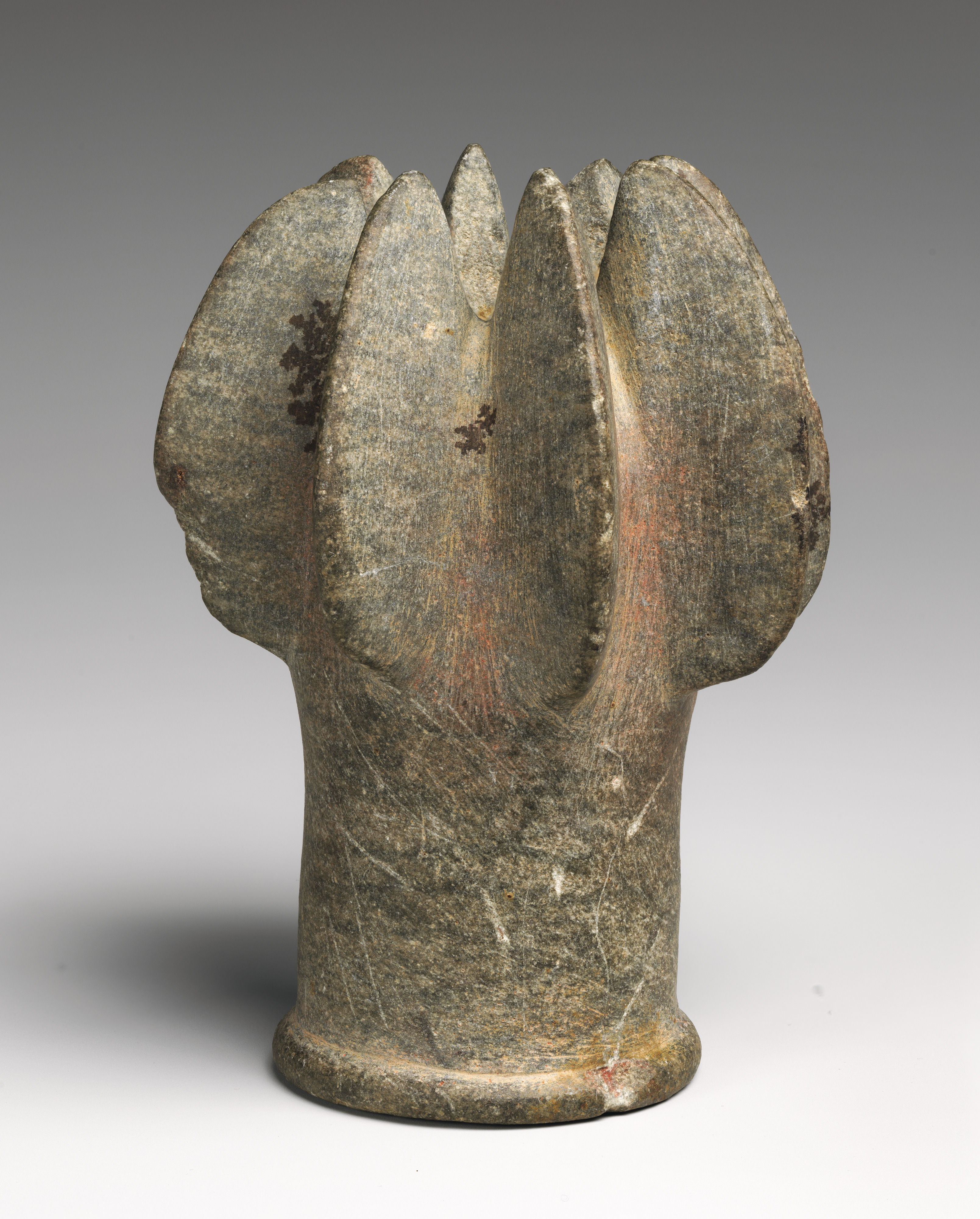Mace head
This carefully carved mace head is crowned by eight vertical fan-like projections or flanges. A hollow central core would have allowed for the insertion of a wood shaft to serve as a handle. Such weapons were deadly effective: the narrow edges of the projections provide points of contact that would have exerted much more force than when struck than a simple round stone, similar to the way in which being stepped upon by a stiletto heel is much more painful than being stepped upon by a wider heel.
Carved stone mace heads were made as early as the middle of the first millennium BCE in the Central Andes, by artisans of the Chavín, Cupisnique, and Salinar cultures. Some examples were clearly used in battle, and some became part of funerary assemblages. A sculpted mace head was excavated from a burial at Kuntur Wasi in the northern highlands of Peru, for example (Fux, 2013:310, cat. no. 105). Objects stylistically similar to the present mace head have been excavated from burials of the Salinar culture, which dominated Peru’s northern coastal region from 450 BCE–150 CE (Burger, 1998; Ikehara and Chicoine 2011; Prieto et al. 2023; Strong and Evans, 1952:55–56, pl. IIIE).
The Cupisnique and Chavín traditions disintegrated around 500 BCE. After centuries of existence, monumental temples decorated with colorful murals and friezes were abandoned, and supernatural beings composed of elements of multiple animal predators were replaced in the visual arts by abstract images. In the next centuries, people living on Peru’s North Coast moved their homes and villages to defensive locations, often near hilltop fortresses, in response to a climate of increased violence. By the time of the rise of the Salinar tradition, finely carved weapons such as mace heads became prestige symbols: warriors were seen as essential to communities, eventually acquiring more permanent power and authority, even in peaceful times.
The process by which stone objects were crafted in this period is not known, but the shape was probably accomplished by initially chipping the rock with stone tools, followed by delicate refinements including polishing the mace head with fine quartz sand as an abrasive. The numerous chips on the edges may be the result of striking other stones during battle, as it is unlikely that stone would be fractured by contact with bone or flesh.
Hugo C. Ikehara-Tsukayama, Senior Research Associate, Arts of the Ancient Americas, 2023
References and Further Reading
Burger, Richard L., “Mace Head,” in Andean Art at Dumbarton Oaks, Vol. 1, edited by Elizabeth H. Boone (Washington, DC: Dumbarton Oaks Research Library and Collection, 1996), pl. 9, pp. 84–86.
Chamussy, Vincent. "Empleo de las armas arrojadizas del área centro-andina: ¿Armas de caza o de guerra?" Arqueología y sociedad 24 (2012), pp. 43-87. Fux, Peter, ed., Chavín: Peru’s Enigmatic Temple in the Andes. Zurich: Scheidegger & Spiess, 2013.
Ikehara, Hugo, and David Chicoine. "Hacia una reevaluación de Salinar desde la perspectiva del valle de Nepeña, Costa de Ancash." In Andes 8: Arqueología de la Costa de Ancash, edited by Milosz Giersz and Iván Ghezzi, pp. 153-184. Warsaw: Centre of Precolumbian Studies, University of Warsaw, 2011.
Prieto, Gabriel, Claver W. Aldama-Reyma, Rémy Chapoulle, Stéphan Dubernet, Jhenry F. Agreda-Delgado, Yannick Lefrals, and Elvira Zeballos-Velásquez. “Use, Symbolism, and Access to Red Pigments Based on Hematite and Cinnabar Between 400 B.C. and A.D. 1450 in Huanchaco, a pre-Hispanic Maritime Community on the North Coast of Peru.” Archaeological and Anthropological Sciences 15 (2023), p. 176.
Strong, William D., and Clifford Evans, Jr., Cultural Stratigraphy in the Virú Valley Northern Peru. The Formative and Florescent Epochs. New York: Columbia University Press, 1952.
This image cannot be enlarged, viewed at full screen, or downloaded.
This artwork is meant to be viewed from right to left. Scroll left to view more.



